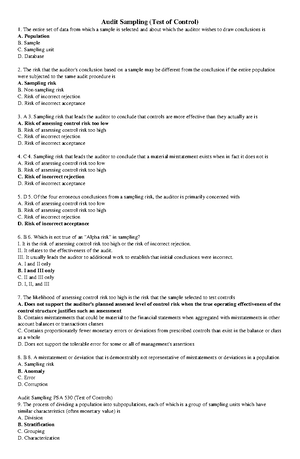- Information
- AI Chat
This is a Premium Document. Some documents on Studocu are Premium. Upgrade to Premium to unlock it.
Was this document helpful?
This is a Premium Document. Some documents on Studocu are Premium. Upgrade to Premium to unlock it.
Internal Control
Course: Accountancy
999+ Documents
Students shared 15910 documents in this course
University: STI College
Was this document helpful?
This is a preview
Do you want full access? Go Premium and unlock all 7 pages
Access to all documents
Get Unlimited Downloads
Improve your grades
Already Premium?

Internal Control
1. Internal control is concerned with the reliability of financial information. True
2. The Foreign Corrupt Practices Act prohibits bribes to foreign corporate officials to obtain business. False
3. Incompatible duties exist when an employee is in a position to perpetrate and conceal errors or fraud. True
4. Well-designed internal control will prevent all fraud by top management. False
5. CPA firms may use written narratives to describe internal control in their audit working papers True
6. Internal auditors should preferably report to the chief accounting officer of the company. False
7. The auditors' communication of internal control significant deficiencies should be addressed only to senior False
management of the company.
8. If the auditors' assessment of the design of internal control reveals that it cannot be relied upon, the auditors False
Are NOT required to prepare any documentation of internal control for their working papers
9. The relatively low number of types of transactions incurred by small firms makes the segregation of duties False
impossible.
10. In a financial statement audit, CPAs are required to assess the operating effectiveness of most significant False
Accounting oriented controls.
11. Which of the following would an auditor most likely consider to be a significant deficiency to be communicated to the
audit committee?
A) Management's failure to negotiate unfavorable long-term purchase commitments
B) Recurring operating losses that may indicate going concern problems
C) Evidence of a lack of objectivity by those responsible for accounting decisions
D) Management's current plans to reduce its ownership equity in the entity
12. In assessing the objectivity of a client's internal auditors, the CPA would be most likely to consider internal auditor:
Organizational status within the company
13. In a financial statement audit performed following AICPA Professional Standards, how frequently must an auditor test
operating effectiveness of controls that appear to function as they have in past years and on which the auditor wishes to
rely upon in the current year?
At least every third audit.
14. After obtaining an understanding of internal control and arriving at a preliminary assessed level of control risk, an
auditor decided to perform tests of controls. The auditor most likely decided that:
It would be efficient to perform test of controls that would result in a reduction in planned substantive procedures
15. Which of the following is LEAST likely to be evidence of operating effectiveness of controls?
A. Cancelled supporting documents
B. Confirmations of accounts receivable
C. Records documenting usage of computer programs
D. Signatures on authorization forms
16. Which of the following is NOT ordinarily a procedure for documenting an auditor's understanding of internal control
for planning purposes?
A) Checklist
B) Flowchart
C) Questionnaire
D) Confirmation
17. Tests of controls do NOT ordinarily address:
The cost effectiveness of the way a control was applied
18. Which is most likely when the assessed level of control risk increases?
A) Change from performing substantive procedures at year-end to an interim date
B) Perform substantive procedures directed inside the entity rather than tests directed toward parties outside the entity C)
use the maximum number of dual purpose tests
D) Use larger sample sizes for substantive procedures
19. Which of the following must the auditor communicate to the audit committee?
A) Significant deficiencies and material weaknesses
B) Only significant deficiencies
C) Only material weaknesses
D) Neither significant deficiencies nor material weaknesses
Why is this page out of focus?
This is a Premium document. Become Premium to read the whole document.
Why is this page out of focus?
This is a Premium document. Become Premium to read the whole document.




